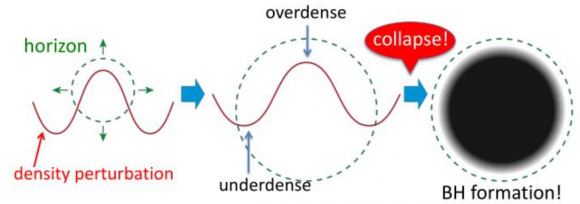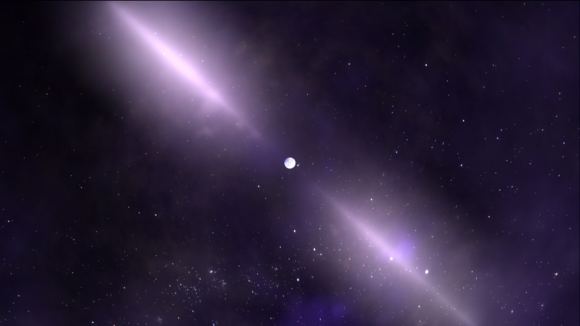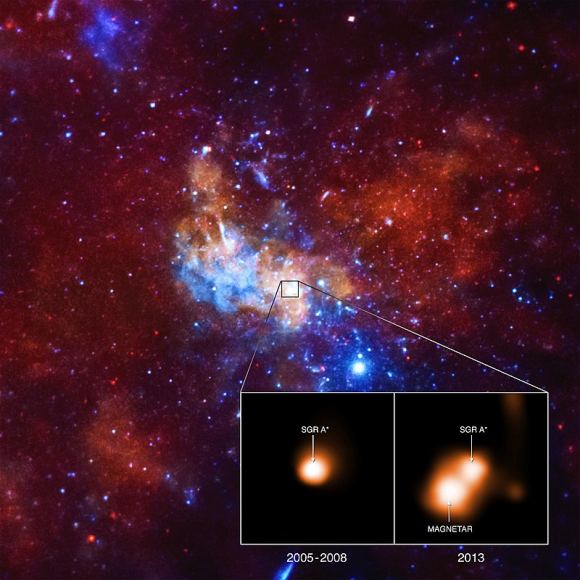The core of the Milky Way has a missing pulsar problem. Astronomers have been trying to explain this for years. One of the more interesting ideas comes from a group of astronomers in Europe, which cites dark matter, neutron stars and primordial black holes (PBHs).
Roberto Caiozzo, an astronomer at the International School for Advanced Studies in Trieste, Italy, leads a team studying the problem of missing pulsars. “We did not observe any type of pulsar in this inner region (except for the magnetar PSR J1745-2900),” he wrote in an email. “This was thought to be due to technical limitations, but observations of magnetars seem to indicate otherwise.” This magnetar orbits Sagittarius A*, the black hole at the core of the Milky Way.
The team looked at other possible reasons why pulsars did not appear in the core, and took a closer look at the formation of the parent star and the destruction of the neutron star. One interesting idea they investigated was the cannibalization of primordial black holes by neutron stars. The team approached the missing pulsar problem by asking the following question: Could cannibalism of neutron stars and primordial black holes explain the lack of detected millisecond pulsars in the core of the Milky Way? Let’s take a look at the major players in this mystery to see if this is going to happen.
Neutron stars, pulsars, and small black holes, oh my god
Theory suggests that primordial black holes were formed in the first seconds after the Big Bang. “PBHs are not known to exist,” Caozzo points out, “but they seem to explain some important astrophysical phenomena.” He points to the idea that supermassive black holes appear to have existed in the early universe, and suggests they may be these Monster Seed. If PHBs exist, the upcoming Nancy Grace Roman Telescope could help find them. Astronomers predict their masses could range from the mass of a pin to about 100,000 times the mass of the Sun. There may be an intermediate range in between, the so-called “asteroid mass” PBH. Astronomers believe these last substances are candidates for dark matter.

Dark matter makes up about 27% of the universe, but astronomers still don’t know what it is, aside from hints that PBH may be part of its content. There does appear to be a large amount of this material in the core of our galaxy. However, it has not been directly observed and therefore its existence has been inferred. Is it related to those mid-range PBHs? no one knows.
The third player in the mystery of the missing pulsar is the neutron star. They are huge, quivering balls of neutrons left behind after the death of a supergiant star with a mass of 10 to 25 solar masses. Neutron stars start out very hot (in the range of 10 million K) and cool over time. They start spinning very fast and they actually create a magnetic field. Some emit beams of radiation (usually radio frequencies) that appear as “pulses” of emission as they rotate. This earned them the nickname “Pulsars”. Neutron stars with extremely strong magnetic fields are called “magnetars.”

The missing pulsar problem
Astronomers have searched for pulsars in the core of the Milky Way without much success. After survey after survey, no radio pulsars have been found within 25 parsecs of the Milky Way’s core. why is that? Caizo and his co-authors suggest in their paper that the formation of magnetars and other disruptions of neutron stars that influence pulsar formation do not fully explain the absence of these objects in the Milky Way’s core. “Efficient magnetar formation could explain this (because of their shorter lifetimes),” he said, “but there is no theoretical reason to expect this. Another possibility is that the pulsar is otherwise affected by something. kind of interference.
Typically, destruction occurs in binary star systems where one star is more massive than the other and explodes as a supernova. The other star may or may not explode. Something might kick it out of the system entirely. The surviving neutron star became a “broken” pulsar. They are not easily observed, which could explain the lack of radio detections.
If the companion star hadn’t been kicked out and subsequently expanded, its material would have been sucked away by the neutron star. This causes the neutron star to spin and affects the magnetic field. If the second star remains in the system, it will later explode and become a neutron star. The result is a double neutron star. This disruption may help explain why the Milky Way’s core appears to be devoid of pulsars.
Using primordial black hole capture to explain missing pulsars
Caizo’s team decided to use a two-dimensional model of a millisecond pulsar, a pulsar that spins extremely fast, to study the possibility of capturing a primordial black hole in the core of the Milky Way. The process works like this: A millisecond pulsar somehow interacts with a primordial black hole that’s less massive than a star. Eventually, a neutron star (with a gravity strong enough to attract a PBH) captures the black hole. Once this happens, the PBH sinks into the core of the neutron star. Inside the core, the black hole begins accreting material from the neutron star. Eventually, all that’s left is a black hole with roughly the same mass as the original neutron star. If this happens, it could help explain the lack of pulsars in the inner parsec of the Milky Way.
Will this happen? The team studied the possible rates at which neutron stars capture PBHs. They also calculated the likelihood of certain neutron star collapses and assessed the rate of destruction of pulsars in the Milky Way’s core. If not all destroyed pulsars are or were once part of binary systems, then neutron star capture of PBHs becomes another way to explain the lack of pulsars in the core. But, will it really happen in reality?
Missing pulsar tension continues
It turns out that cannibalism cannot explain the missing pulsars, Caizo said. “We found that in our current model, PBH is unable to destroy these objects, but this is only a simplified model that takes into account our 2-body interaction,” he said. It does not rule out the existence of PHB, just that in certain cases, such capture will not occur.
So, what else needs to be checked? If there are PHBs in the core and they are being merged, no one has seen them yet. But the center of the Milky Way is a busy place. Many bodies crowded the central parsec. You have to calculate the effect of all these objects interacting in such a small space. “Many-body dynamics” problems must consider other interactions, as well as the dynamics and trapping of PBHs.
Astronomers hoping to use PBH-neutron star mergers to explain the lack of observations of pulsars in the Milky Way core need a better understanding of the proposed observations and the larger pulsar population. The research team believes that future observations of old neutron stars near Sagittarius A* may be very useful. They will help set tighter limits on the number of PBHs in the core. Additionally, it is useful to know the qualities of these PBHs, since the interactions of lower-end PBHs (asteroid mass types) can be very different.
to know more information
Revisiting the primordial black hole captured by a neutron star
Searching for pulsars at 3 mm and 2 mm at the center of the Milky Way
#Neutron #stars #capturing #primordial #black #holes
Image Source : www.universetoday.com
